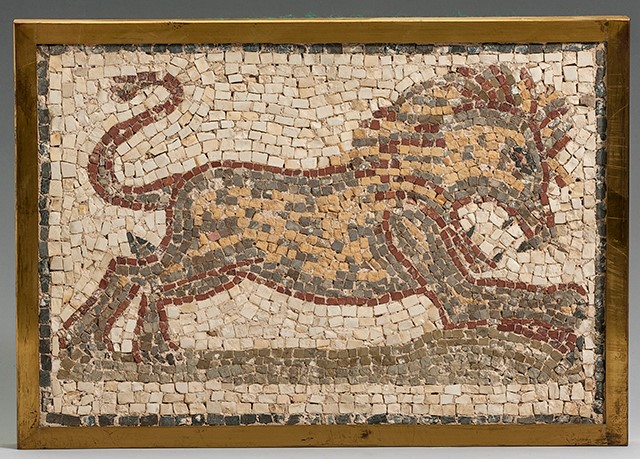Acquisition number: 1970.02
Mosaic panel of a lion running right, its mouth open. The tesserae are relatively large (ca 260 per 10cm2) and tend to follow the outline of the figure. The colours are (1) cream-white, for the background, (2) grey-green, for the ground on which the lion runs, (3) black, (4) light grey, turning to grey-green when wet, (5) yellow-buff, (6) purple-red. The body of the lion is of yellow and grey with the deep red for the outlines and the eye. The eye is outlined in black and triangular pieces of black are used for the teeth and claws. The border of the panel is in black. The whole is set in a modern brass frame.
Title: Roman Mosaic of a Lion - 1970.02
Acquisition number: 1970.02
Author or editor: J.R. Green
Culture or period: Roman Imperial
Date: 4th - 5th century AD.
Material: Stone
Object type: Mosaic
Dimensions: 330mm (w) × 224mm (h)
Origin region or location: Tunisia
Origin city: El Djem
Display case or on loan: 12
Keywords: Roman, Imperial, mosaic, El Djem
Folio Fine Art Ltd (London), Catalogue 70 (February 1970) no. 722 (ill.); Three Thousand Years of Classical Art (Exhibition Cat., Sydney, 1970) no. 78; J.R. Green with B. Rawson, Catalogue of Antiquities in the Australian National University, A.N.U. (Canberra, 1981) 106.
1970.02
Roman Mosaic of a Lion
Purchased. Said to be from El Djem in Tunisia. Ht 22.4cm; width 33cm.
Mosaic panel of a lion running right, its mouth open. The tesserae are relatively large (ca 260 per 10cm2) and tend to follow the outline of the figure. The colours are (1) cream-white, for the background, (2) grey-green, for the ground on which the lion runs, (3) black, (4) light grey, turning to grey-green when wet, (5) yellow-buff, (6) purple-red. The body of the lion is of yellow and grey with the deep red for the outlines and the eye. The eye is outlined in black and triangular pieces of black are used for the teeth and claws. The border of the panel is in black. The whole is set in a modern brass frame.
The size and arrangement of the tesserae and the treatment of the lion suggest a late imperial date. From the beginning of the fourth century AD depictions of figures became less concerned with the representation of volume and depth, and more interested in the surface and pattern effect of colour and outline. Compare for instance the boar in the boar-hunt scene from Piazza Armerina of the beginning of the fourth century (e.g. H. Kahler, Die Villa des Maxentius bei Piazza Armerina [Berlin 1973] pl. 23a; G.V. Gentili, La Villa Erculia di Piazza Armerina [Rome 1959] pl. 22 [colour]). Ours is clearly later.
For mosaics from this area of North Africa, see L. Foucher, Le Musée de Sousse (Tunis 1951); K.M. Dunbabin, Mosaics of Roman North Africa (Oxford 1978), and M. Yacoub, Le Musée du Bardo (Tunis 1993). There is also an excellent book from the British Museum: M. Blanchard-Lemée et al., Mosaics of Roman North Africa. Floor Mosaics from Tunisia (London 1996) and the attractive volume edited by M.H. Fantar, La mosaïque en Tunisie (Paris 1994). The standard and most reliable work on mosaics in general is K. Dunbabin, Mosaics of the Greek and Roman World (Cambridge 1999).
Folio Fine Art Ltd (London), Catalogue 70 (February 1970) no. 722 (ill.); Three Thousand Years of Classical Art (Exhibition Cat., Sydney, 1970) no. 78; J.R. Green with B. Rawson, Catalogue of Antiquities in the Australian National University, A.N.U. (Canberra, 1981) 106.
